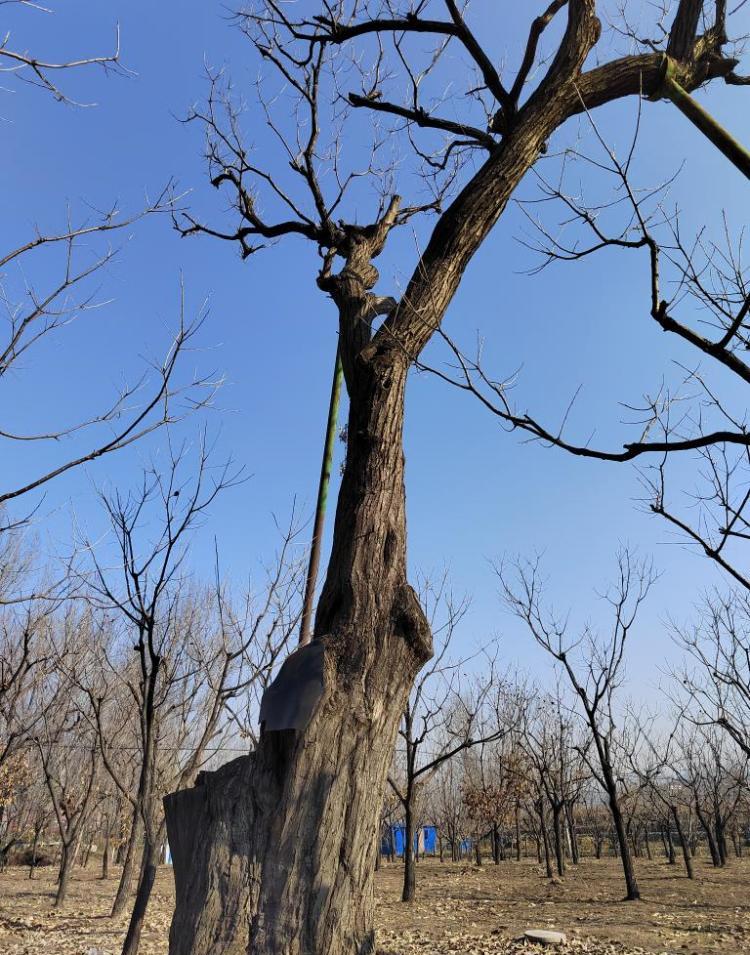Chestnuts in Kuancheng County, Hebei Province, are known for their soft sticky sweetness, and the chestnut trees widely planted along the Great Wall are not only cash crops, but also have deep historical and cultural origins. According to the latest research by local experts, the existing ancient chestnut gardens with a history of about 500 years in Kuancheng are actually the important military auxiliary facilities of the Ming Great Wall, "Shubian Forest", which is another "Green Great Wall" attached to the Masonry Great Wall.
Since ancient times, Kuancheng has been the throat of the Central Plains to the northern and northeastern frontiers. The Ming Great Wall stretches for about 60 kilometers in Kuancheng and is an important part of the Great Wall of Jizhen in the Ming Dynasty.

This is an ancient chestnut tree in the territory of Kuancheng, Hebei.
Zhang Lixin, deputy director of the Kuancheng County Tourism, Culture, Radio, Film and Television Bureau, introduced that there are many ancient chestnut gardens at the foot of the Great Wall of Kuancheng, the open land in front of the pass and the traffic artery in the valley. The trunks of these ancient chestnut trees are more than 1 meter in diameter, and most of them are about 500 years old according to the Hebei Academy of Agriculture and Forestry Sciences.
Why were chestnut trees planted here in the middle of the Ming Dynasty? Zhang Lixin consulted the historical records of the Ming Dynasty: During the Ming Jiajing period, he began to plant "Shubian Forest" in the key area of the Great Wall of Jizhen. During the Ming Dynasty and the Wanli Dynasty, for the sake of military defense needs and economic purposes, Qi Jiguang and other generals organized border guards and ordinary people to build the Masonry Great Wall and the Enemy Platform, and also extensively planted chestnuts, mulberries, jujubes, and other local economic tree species along the Great Wall, especially on the flat and open land through which soldiers and horses must pass, on the basis of the elm willow peach apricots planted according to the regulations of the imperial court. The tree-rich "Shubian Forest" creates another "Green Great Wall" in addition to the Masonry Great Wall. To this day, the locals have given chestnuts the name of administrative and military color - Feng Pulp (Fengjiang) and Dali (吏).
Meng Qi, an expert of the Hebei Provincial Institute of Cultural Relics and Ancient Building Protection and president of the Hebei Great Wall Association, believes that the Ming Great Wall does not exist in isolation as a military defense facility, and the miscellaneous trees such as elm willows, horse pits, pinzi kilns, retaining horse walls and masonry Great Wall inside and outside the Great Wall have built an all-round, multi-form, buffered, and deep multi-layer defense system.
Meng Qi believes that as an important military auxiliary facility of the Ming Great Wall, the Ancient Chestnut Garden is an effective measure adopted by the Ming Army to strengthen defense in depth, slow down the attack speed of the opposing cavalry, and reduce the superiority of the cavalry, and is a "Green Great Wall" of military, cultural, and economic significance, which greatly enriches the cultural connotation of the Great Wall and expands the new field of great wall cultural research.
Reporter: Wang Min
Editors: Liao Yi, Luan Ruohui
Images courtesy of respondents